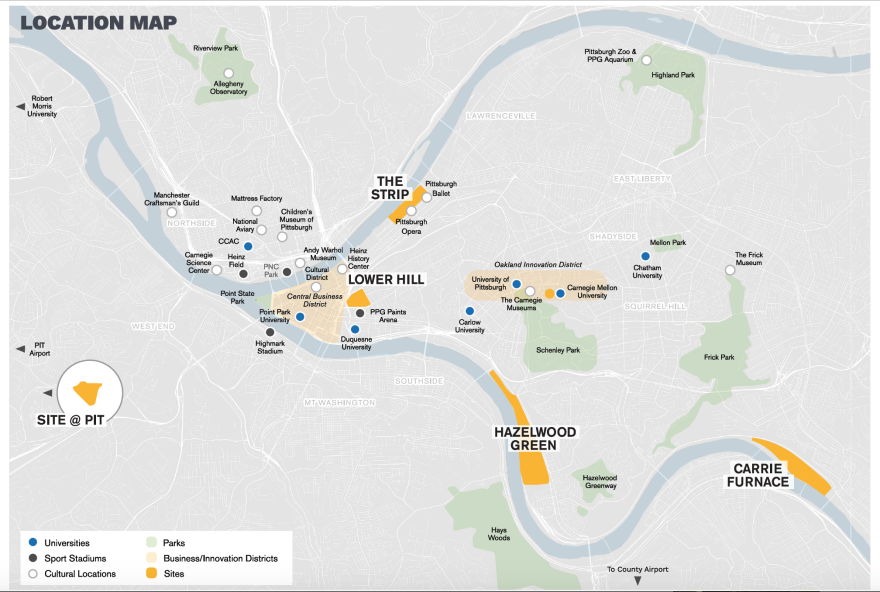The opening pages of Pittsburgh’s bid for Amazon describe the region as proactive and innovative, and tout it as a place of partnership with an enviable cost of living. “The world’s most customer-centric company deserves a customer-centric home,” it reads. “In Pittsburgh, you will be our neighbor, and we will treat you like one.”
At a news conference Thursday, Mayor Bill Peduto, Allegheny County executive Rich Fitzgerald, and Stefani Pashman, CEO of economic development organization Allegheny Conference, released the HQ2 proposal, which said their aim was to build “a new social compact” with one of the world’s most valuable companies.
Between the state of Pennsylvania, Allegheny County and the city of Pittsburgh, the bid offered Amazon $6.7 billion dollars in incentives. However, coupled with other benefits — long-term cost savings derived from the region’s relatively affordable cost of living and development-ready sites that the state would have paid for — the total value to the company was projected to be $21.6 billion.
“Now, I guess the question you all want to have, what were they getting locally,” said Fitzgerald. “Zero. There were no existing tax dollars that were going to Amazon.”
Incentives on the table
However, most incentives use future revenue. Officials estimated that the arrival of HQ2 would create 50,000 new jobs at Amazon as well as 60,000 indirect jobs, a hiring wave expected to generate $5.8 billion in new tax revenue over 20 years.
Two-thirds of that was expected to go unencumbered into the operating budgets of the city, the county, and Pittsburgh Public Schools.
The remaining revenue, estimated at $2.1 billion, would have been dedicated to funding a new economic development strategy called Forging Pittsburgh’s Future, said Mayor Bill Peduto.
“The issue of, it was just going into Jeff Bezos’ pocket is not a fair or valid argument,” he said. “It would have gone back to the major issues that we have within this city and this region, and funded those initiatives to be able to make the benefit for all.”
Those initiatives included neighborhood improvement and affordable housing expansion, workforce development, and infrastructure efforts: water, sewage, and transit.
That $2.1 billion would have been captured through something like tax increment financing: all three taxing bodies would have had to agree, and take out a loan to cover the costs of investing in regional priorities. Taxes on all the new employees’ wages would go to pay off the loan. Officials said Amazon would have been one of the loan’s guarantors.
Peduto and Fitzgerald said all of the new tax revenues—$5.8 billion—generated from Amazon’s HQ2 would run through the regular government processes of the city and county. TIFs are negotiated by all three taxing bodies; the funds are subject to government oversight but there’s a lot of room to hammer out specifics. In negotiating the Forging Pittsburgh’s Future initiative Amazon could have had a greater say in how the $2.1 billion was spent.
A regional effort
The Amazon proposal was just one more opportunity to market and brand Pittsburgh for business attraction, said Pashman, CEO of the Allegheny Conference.
“What was different about the Amazon opportunity was the scale and the unprecedented investment it would bring in terms of job and capital expenditures in our region,” she said.
More than 400 stakeholders put the region’s bid together, according to officials. Exclusive options for five main sites were negotiated with landowners and held through much of 2018, according to the bid: the former Civic Arena site in the Lower Hill District, the Strip District, Pittsburgh International Airport, Hazelwood Green, and the Carrie Furnace. Thirty additional sites scattered throughout the near suburbs were offered.

“There was an opportunity for [Amazon] to purchase the land free, depending on the site,” said Peduto, referencing the state’s promise to foot the bill for real estate transactions.
In addition, Pennsylvania would annually have reimbursed Amazon the state income taxes of its new employees up to $4.5 billion.
Life after Amazon
It is unclear how much it cost to create the region’s proposal and to defend it from numerous Right To Know requests, which proceeded to county and state courts before today’s disclosure.
“The legal fees were nothing because we just used existing staff at the county and city level,” said Fitzgerald.
Peduto and Fitzgerald could not provide an estimate for how much time those staff members, whose salaries are paid with taxpayer dollars, spent fighting requests to make the bid public. They also did not have an estimate of how much staff time was spent putting the proposal together.
“We used existing staff, that’s what the departments do, same with the economic development department,” said Fitzgerald.
Officials said they kept their word in releasing the bid, and that they’re proud of both the cooperation in the region and the bipartisan effort in Harrisburg that made it possible. They intend to continue marketing Pittsburgh for new businesses and opportunities.
Peduto, Fitzgerald and Pashman all said they were not aware Amazon intended to create an operations center expected to employ 5,000 people; that was awarded to Nashville. HQ2 will be split between Long Island City, in New York and Crystal City, in northern Virginia. Each are expected to see $2.5 billion in investment and 25,000 new jobs.




